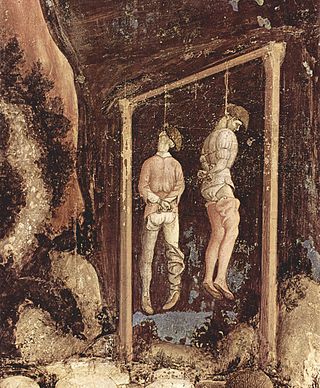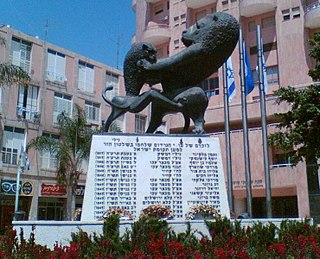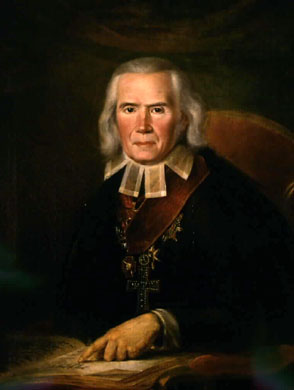Related Research Articles

Mikael Agricola was a Finnish Lutheran clergyman who became the de facto founder of literary Finnish and a prominent proponent of the Protestant Reformation in Sweden, including Finland, which was a Swedish territory at the time. He is often called the "father of literary Finnish".

Magnus Ladulås or Magnus Birgersson,, was King of Sweden from 1275 until his death in 1290.

Hanging is killing a person by suspending them from the neck with a noose or ligature. Hanging has been a common method of capital punishment since the Middle Ages, and is the primary execution method in numerous countries and regions. The first known account of execution by hanging is in Homer's Odyssey. Hanging is also a method of suicide.

Erik "Eero" Nikolai Järnefelt was a Finnish painter and art professor. He is best known for his portraits and landscapes of the area around Koli National Park. He was a medal winner at the Paris Exposition Universelle of 1889 and 1900, and he taught art at the University of Helsinki and was chairman of the Finnish Academy of Fine Arts.

Henry was a medieval English clergyman. He came to Sweden with Cardinal Nicholas Breakspeare in 1153 and was most likely designated to be the new Archbishop of Uppsala, but the independent church province of Sweden could only be established in 1164 after the civil war, and Henry would have been sent to organize the Church in Finland, where Christians had already existed for two centuries.

Huittinen is a town and municipality in Finland. It is located in the Satakunta region, 63 kilometres (39 mi) southeast of Pori and 75 kilometres (47 mi) southwest of Tampere. The town has a population of 9,646 and covers an area of 539.59 square kilometres (208.34 sq mi) of which 6.97 km2 (2.69 sq mi) is water. The population density is 18.11 inhabitants per square kilometre (46.9/sq mi).

Vampula is a former municipality of Finland. It was consolidated with Huittinen on 1 January 2009.

Mikael Åke Persbrandt is a Swedish actor. In Swedish films, he is perhaps best known for playing Gunvald Larsson in the Beck series of movies. He is internationally known for his starring role in the Academy Award-winning feature, In a Better World, directed by Susanne Bier. His performance earned him a 2011 European Film Award nomination for Best Actor. Other parts include the role of Carl Hamilton from the novels by Jan Guillou, Beorn in The Hobbit, as well as Jakob Nyman in the English TV series Sex Education.

Capital punishment in Sweden was last used in 1910, though it remained a legal sentence for at least some crimes until 1973. It is now outlawed by the Swedish Constitution, which states that capital punishment, corporal punishment, and torture are strictly prohibited. At the time of the abolition of the death penalty in Sweden, the legal method of execution was beheading. It was one of the last states in Europe to abolish the death penalty.

The Fleming family or Flemming is a Finnish noble family with a medieval frälse origin.

Olei Hagardom refers to members of the two Jewish Revisionist pre-state underground organisations Irgun and Lehi, most of whom were tried in British Mandate military courts and sentenced to death by hanging. Most of the executions were carried out at Acre Prison. There were 12 Olei Hagardom.

Lars Larsson Molin, alias Lasse-Maja, was a Swedish thief and memoirist. He was famous in history for disguising himself as a woman during his tours as a thief. His disguise gave him the nickname Lasse-Maja, a combination of the male name Lars and the female name Maja. He wrote his own memoirs, which became very popular in 19th-century Sweden.

Helvig of Holstein was Queen of Sweden as the consort of King Magnus Ladulås. Her parents were Gerhard I, Count of Holstein-Itzehoe and Elisabeth of Mecklenburg.

Jacob Tengström was a Finnish prelate who became the first Archbishop of Turku and Finland.
Christina Abrahamsdotter (1432–1492) was a Finnish woman, royal mistress and briefly queen of Sweden as the third wife of King Charles VIII.

Per Michael "Joe" Ljunggren was a Swedish outlaw biker and gangster who served as the first national president of the Bandidos Motorcycle Club in Sweden. Ljunggren was a central figure in the Nordic Biker War, in which the Bandidos feuded with the Hells Angels. He was shot dead while riding his motorcycle on the E4 motorway in Småland. The murder remains unsolved, but police believe members of the Hells Angels to be responsible.

Toivo Harald "Kirves" Koljonen was a Finnish mass murderer and the last Finn executed for a civilian crime. He was executed by firing squad for a sextuple murder.

Berndt Abraham Godenhjelm was a Finnish painter.

Murders and executions in Stockholm, Sweden have been documented since the 1280s, when King Magnus Ladulås ordered the execution of three magnates of the Privy Council, who had been accused of several "traitorous acts against the throne". The city's murders between the middle of the 15th century and the middle of the 17th century have been documented fairly well in the logs of Stockholm City Court. Violence with a deadly outcome was most common during the Middle Ages, a trend which had more than halved by the beginning of the 1700s. The most common cases of manslaughter and murder usually involved fights between men where alcohol was involved.
The Witch trials in Finland were conducted in connection to Sweden and were relatively few with the exception of the 1660s and 1670s, when a big witch hunt affected both Finland and Sweden. Finland differed from most of Europe in that an uncommonly large part of the accused were men, which it had in common with the witch trials in Iceland. Most of the people accused in Finland were men, so called "wise men" hired to perform magic by people. From 1674 to 1678, a real witch hysteria broke out in Ostrobothnia, during which twenty women and two men were executed.
References
- 1 2 3 Huldén, Lena (2005). "Lasse Huittisista". Suomen kansallisbiografia, osa 5 (in Finnish). Suomalaisen kirjallisuuden seura. pp. 748–749.
- 1 2 "Lasse Huittisista (K 1488)". kansallisbiografia.fi (in Finnish).
- 1 2 3 4 E. Hildebrand (1903). Historisk Tidskrift (in Swedish). p. 151. Retrieved December 15, 2022.
- 1 2 Berg, Harald (2019). Tyresö under tusen år (in Swedish). p. D5.
- ↑ "DF 4195". Diplomatarium Fennicum (in Finnish). National Archives of Finland . Retrieved March 15, 2023.
- ↑ Schück, Henrik (1951). Stockholm vid 1400-talets slut [Stockholm at the end of the 15th century] (in Swedish) (2nd ed.). p. 443.